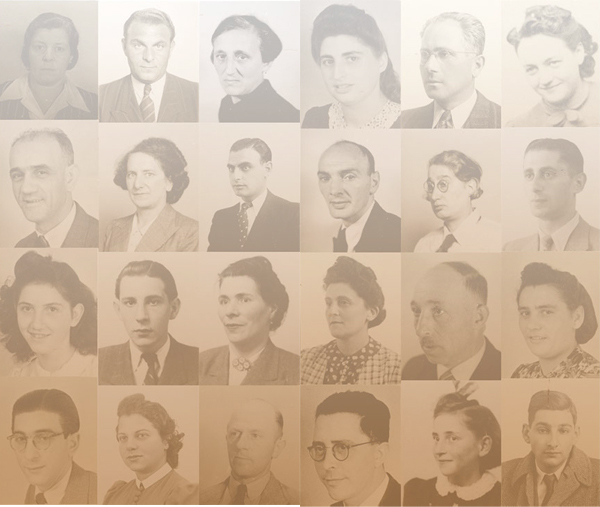The General Dutch Diamond Workers Union (ANDB) was founded in 1894 after a big strike to improve the working conditions in the diamond industry.
Founders were among others Henri Polak and Jan van Zutphen.
The Union was extremely successful and succeeded (often as the first trade union in the Netherlands) in effectuating many regulations, that improved the status of the diamond workers, like minimum wages, an insurance in case of illness, invalidity, unemployment and death, an 8-hours working day and payment for a week of vacation.
Many Jewish diamond workers found their way to the Social Democratic Labour Party (the SDAP) and other leftist parties through the ANDB.
In addition to all the activities to improve the material status of the diamond workers, the Union, and especially its chairman Henri Polak, strived “to cultivate” the diamond workers and bring them into contact with the arts and culture.
The ANDB had its own library, initiated all kind of courses and organised excursions.
Polak also requested the famous architect H.P. Berlage to design a building for the ANDB union.This magnificent building, immediately called “the Castle” (“de Burcht”) because of its imposing appearance, stands in what is now called the Henri Polak Avenue (Henri Polaklaan) and houses the Trade Union Museum (het Vakbondsmuseum).
This database is based upon application forms for about 500 Jewish diamond workers and their families for a temporary dispensation of deportation in July 1942.
Diamonds, both the cut diamonds that were used as `negotiable instruments`,
as well as the industrial diamonds were very important for the German warfare.
This industrial branch therefore fell within the directives of the Rijkscommissariaat (“The Reich’s commisionary”).
Problems arose when the deportations started in July 1942 and this mostly Jewish professional group was in danger of being deported.Therefore a list of 500 diamond workers and 300 enterpreneurs that should get a temporary dispensation had to be drawn up.
The afore mentioned list was drawn up with the assistance of the Business Group Fine Metals and Diamonds that came into being in 1941 after the ANDB was dissolved.
545 Jewish diamond workers personally filled in the application questionnaires with details about themselves, their partner and children up to the age of 16, living with them, in total 1230 persons.A photo in passport format of all individuals mentioned on the questionnaire had to be attached in threefold.
The application forms and the majority of the photographs survived
and can be found in the archive of the ANDB kept by the IISG-Internationaal Instituut voor Sociale Geschiedenis (the International Institute for Social History).
Om de arbeidsomstandigheden in de diamantindustrie te verbeteren werd in 1894 na een grote staking de Algemene Nederlandse Diamantbewerkersbond (ANDB) opgericht. Oprichters waren ondermeerHenri Polak en Jan van Zutphen, De bond werd bijzonder succesvol en wist (vaak als eerste vakbond in Nederland) een groot aantal maatregelen te treffen die de positie van de diamantbewerkers verbeterden zoals minimumlonen, een verzekering bij ziekte, invaliditeit, werkloosheid en overlijden, de 8-urige werkdag en een betaalde vakantieweek. Veel joodse diamantbewerkers vonden via de ANDB hun weg naar de Sociaal Democratische Arbeiderspartij (SDAP) en andere linkse partijen.
Naast alle activiteiten om de materiële positie van de diamantbewerkers te verbeteren, spande de Bond, en vooral voorzitter Henri Polak, zich in om de diamantbewerkers 'te beschaven' en ze in contact te brengen met kunst en cultuur. De ANDB had een eigen bibliotheek, gaf allerlei cursussen en organiseerde excursies. Ook vroeg Polak de bekende architect H.P. Berlage om het bondsgebouw van de ANDB te ontwerpen. Het prachtige gebouw, door zijn imposante voorkomen onmiddellijk 'de Burcht' genoemd, staat in wat nu de Henri Polaklaan heet en biedt plaats aan het Vakbondsmuseum.
Dit gegevensbestand bestaat uit formulieren waarmee ruim 500 joodse diamantbewerkers en hun gezinsleden zich in juli 1942 konden aanmelden voor een voorlopige vrijstelling van deportatie
Diamanten, zowel de sierdiamanten die als ‘waardepapieren’ gebruikt werden, als de industriediamanten waren voor de Duitse oorlogsvoering erg belangrijk. De bedrijfstak viel daarom direct onder het Rijkscommissariaat.
Problemen ontstonden toen in juli 1942 de deportaties begonnen en deze grotendeels joodse beroepsgroep weggevoerd dreigde te worden. Daarom moest er een lijst van 500 diamantbewerkers en 300 ondernemers opgesteld worden die een voorlopige vrijstelling moesten krijgen. Het opstellen van de eerstgenoemde lijst gebeurde met hulp van de Bedrijfsgroep Edelmetaal en Diamant die in 1941 na de liquidatie van de ANDB in werking trad. 545 joodse diamantbewerkers vulden zelf aanmeldingsformulieren in met gegevens over henzelf, hun partner en hun inwonende kinderen jonger dan 16 jaar, samen in totaal 1230 personen. Een pasfoto van alle op het formulier genoemde personen moest in drievoud worden bijgevoegd. Deze aanmeldingsformulieren en een groot deel van de pasfoto’s zijn bewaard gebleven en bevinden zich in het ANDB-archief dat op het IISG berust.
